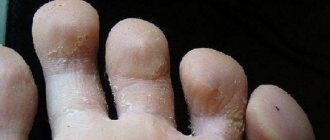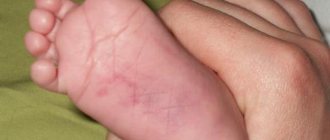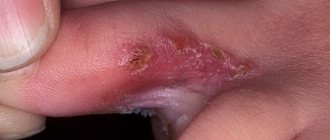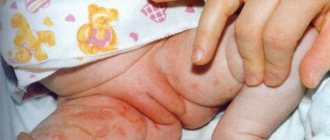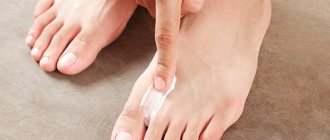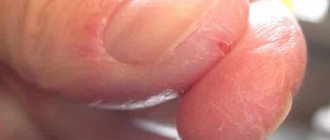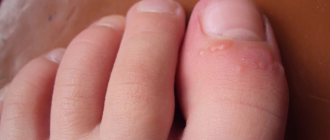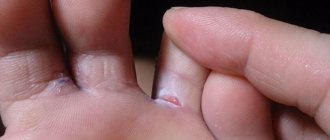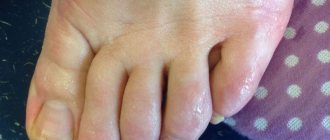Symptoms of a fungal infection
What does interdigital fungus look like? Signs of the disease are difficult to confuse with something else, and an experienced doctor will only need one look at the patient to make a diagnosis. Typical symptoms allow you to recognize the fungus at the earliest stage of its appearance:
- cracks or sores between the toes;
- excessive peeling (yellow or whitish scales);
- areas of peeling skin between the fingers;
- itching;
- getting wet.
Symptoms of the disease can be very varied. In some people, fungus between the toes appears as weeping sores.
In some cases, ulcers and cracks may be covered with typical whitish or yellowish scales. Peeling can be quite severe or slightly noticeable.
Often, areas of loose and dead skin appear between the toes. A typical sign of a fungal infection is itching, but its severity can vary greatly.
For some, itching becomes a very painful companion to the disease, while for others the fungus causes only mild discomfort. The skin with mycoses is usually red, there may be traces of scratching.
All these signs make it possible to accurately recognize foot fungus and distinguish it from other skin diseases.
A fungal infection between the toes is quite often combined with nail infections. A typical nail fungus looks like this:
- thickening of nails;
- change in nail color (from pale pink to yellow, gray or brown);
- peeling of nails;
- fragility of the nail plate;
- itching and soreness around the nails.
Special forms of fungus
In some cases, foot fungus leads to the appearance of not only cracks and weeping ulcers. When a fungal infection develops, small blisters filled with clear or cloudy liquid may appear.
The skin swells and turns red. Over time, the bubbles burst, and in their place shallow depressions appear. The ulcers hurt a lot and heal rather slowly. Scar formation is not typical.
This form of fungal infection is usually called velicular-erosive. With the erased form of the disease, the skin does not change so much. In the chronic course of the disease, the skin peels off only in certain areas.
Peeling and roughening of the skin comes first. Gradually, the skin becomes more and more rough and acquires a characteristic yellowish color. Over time, the process can spread to the lower leg, thigh and gluteal region.
Preliminary prevention of mycosis
To not know what a fungus is, you need:
- Always keep your feet dry , because a humid environment is the best environment for the development of fungal diseases. This is especially true during hot seasons. Wear moderately open shoes and change socks often.
- If possible, avoid wearing another person's shoes . The fungus can form not only due to the transfer of colonies from another person, but also due to contact with foreign microflora.
- When visiting public showers, saunas, steam rooms or baths, you need to have a spare pair of closed rubber slippers with you . It's better if it's disposable.
- Avoid walking barefoot , especially on the beach or in crowded areas.
- Socks or foot wraps should be made of natural cotton fabric . Synthetics irritate the skin and provoke the development of infections.
- Use soap with a neutral pH level , since the fatty layer that covers the skin contains substances that repel infection. By washing it off, you leave your skin without protection.
Diagnostics
In order to recognize fungus on the feet, it is enough to simply carefully examine the skin of the foot, the spaces between the toes and nails. Typical signs of the disease allow no doubt about the diagnosis.
To find out what kind of fungus lives on the skin, you need to take a scraping from the affected areas and send the material to the laboratory. Bacteriological seeding of the material makes it possible to accurately determine the causative agent of the disease.
The results of the examination will be ready in a few days, after which the doctor can begin to treat the fungal infection.
Vitamins
Onychomycosis is a dangerous fungal disease in which the nail plate peels off, crumbles, and falls apart.
Lack of vitamins is a common cause of decreased immunity and metabolic disorders, as a result of which the body can perceive the cells of a fungal infection as its own. The main reason is a deficiency of vitamins:
- E, which is mainly found in seafood.
- A. Fat-soluble vitamin found in lard, eggs, avocados, nuts, beans, broccoli, cabbage.
- C, which is rich in citrus fruits, raspberries, currants, sorrel.
You can also use pharmacy vitamin complexes, such as:
- Aevit.
- Superia.
- Undevit.
- Vitrum Energy.
Local therapy
Treatment of fungus between the toes begins with the selection of antifungal drugs. All means that can treat an infection are divided into general and local drugs.
Local therapy is used in the early stages of the disease, when the fungal infection involves only the skin between the toes. Also, topical preparations are widely used for combined nail lesions.
A wide selection of medicines allows you to choose the right drug for almost any situation. A dermatologist should prescribe antimycotic drugs.
Self-medication in this situation can lead to a worsening of the condition, since the wrong medicine can accelerate the progression of the disease. In addition, many antifungal drugs have a large number of contraindications and can cause serious harm to health.
What remedies help against foot fungus? When interdigital folds are affected, it is best to use creams and ointments. It should be remembered that the skin in this area is quite thin. Careless actions can injure the space between the fingers and lead to the spread of infection.
The ointment or cream should be applied carefully, in a thin layer over cracks and ulcers. When processing, you should cover not only the area affected by the fungus, but also the skin 2-3 cm around the spots.
This is necessary in order to destroy the elements of the fungus in areas of still healthy skin. What is better to use for foot fungus: ointment or cream? The choice depends solely on the form of the disease. The ointment is recommended for application to dry and flaky skin.
It penetrates deeply into the affected area and effectively fights fungus that has become chronic. The ointment can also be applied under the bandage so that the medicine penetrates into the deeper layers of the skin.
Fungal infections should be treated with cream in the stage of severe exacerbation of the disease. Itching, weeping, ulcers and erosions are direct indications for applying the cream. The cream is quickly absorbed into the skin, leaving virtually no traces on clothes.
Preparations in the form of a cream do not penetrate into the deep layers of the skin and are not used for severe roughness and peeling of the skin. Many drugs that eliminate foot fungus are available in two forms at once.
Dermatologists advise applying the ointment at night to enhance the effect of the product on dry and thickened areas of the skin. The cream can be used during the day to eliminate ulcers and weeping, as well as under clothing.
Unlike cream, ointment is absorbed much less easily and often leaves difficult to wash off marks on laundry. What medications can be used to treat fungus between the fingers?
The choice of remedy will depend on the identified pathogen. The most commonly used antimycotic drugs are based on econazole, ketoconazole, terbinafine and other substances.
Many drugs can treat not only fungus, but also bacterial infections, so they can be used for mixed lesions of the skin of the feet.
Prevention
It is easy to catch a fungal infection, but it is very difficult to get rid of it. Prevention helps not only to eliminate the disease, but also to prevent relapses.
- Hygiene. Washing feet daily, treating diaper rash, combating sweating.
- Be careful in public places. It is better to visit saunas and swimming pools with your own shoes. After bathing, it is recommended to treat your feet with an antifungal spray or peroxide.
- Wearing comfortable shoes, eliminating calluses and corns.
- An active lifestyle that allows you to maintain good blood circulation in the lower extremities.
Don't forget about exercise and hygiene
If there is an infected person in the family, all shoes should be disinfected. You cannot use shared hygiene items. After showering, it is better to treat your feet with ointments or aerosols that will help disinfect the skin.
If symptoms of fungus appear between the fingers, it is important to immediately seek help from a specialist and begin treatment as soon as possible. A disease detected in time is easier to treat than an advanced form.
Systemic therapy
Treatment of foot fungus is possible not only with local medications. In some cases, doctors prescribe medications that affect the entire body as a whole.
Systemic therapy may be required if several interdigital spaces are affected at once, as well as if the process spreads to the nails and feet.
In their practice, dermatologists most often use products based on fluconazole and itraconazole. “Diflucan”, “Mikosist”, “Irunin” - all these drugs effectively relieve itching and inflammation and help eliminate the main symptoms of a fungal infection.
- dysbacteriosis;
- dyspeptic disorders (nausea, vomiting, diarrhea);
- headache;
- heart rhythm disturbances;
- liver and kidney damage;
- allergic reactions.
Long-term treatment of foot fungus with systemic drugs can provoke a serious malfunction in the functioning of the entire body.
That is why it is so important that such remedies are prescribed only by a doctor after a full examination. The duration of therapy and dosage of drugs are selected taking into account the course of the infection and the presence of various concomitant pathologies in the patient.
An important point: the course of treatment with systemic antifungal drugs must be completed! Do not interrupt the medication unless absolutely necessary.
Incomplete therapy can lead to the development of drug resistance. In the future, it will be quite difficult to get rid of the mutated fungus and achieve recovery.
Complications
Fungus on the toes is not only a dermatological problem.
Spreading throughout the body and penetrating into the blood, the infection affects internal organs and has a negative impact on the functioning of the entire body:
- Long-term exposure to fungal toxins causes allergic reactions, exacerbation of bronchial asthma, and dermatitis.
- Penetration into the blood disrupts the functioning of internal organs.
- Deep mycosis causes the progression of diabetes mellitus, and against its background gangrene and bone infection can develop.
Folk remedies
Is it possible to treat foot fungus with folk remedies? It is believed that alternative therapy methods can really relieve itching and eliminate other symptoms of fungal infections of the skin and nails.
Kombucha is considered a good remedy for mycosis. This plant was brought from Japan in the last century, and has been very popular for many years.
A small piece of kombucha is rubbed into the spaces between the fingers twice a day for a month. If necessary, the course of treatment can be repeated after a two-week break.
Propolis and tea tree oil are also used to get rid of fungus. Treatment of foot fungus is also possible with the help of regular soda diluted in hot water (at the rate of 1 tablespoon of soda per 3 liters of water).
The cooled solution is used to treat the affected areas of the skin and nails twice a day. It should be remembered that treating fungus with folk remedies is possible only in the early stages of the disease. In advanced cases, when the fungus affects the entire skin of the feet and nails, you should definitely consult a doctor.
Methods for treating fungus with homemade products
- Garlic.
You need to cut off half a clove of garlic, roll it in salt and rub it on problem areas of the skin. Another option for using garlic is to grind the clove into a pulp and make a compress from it on the affected areas or simply rub them with the mixture.
- Onion.
Grind the onion into a paste, then spread it on the sore spots on the surface of the skin. If there are wounds or burst blisters on the skin, you can add Vaseline to the onion mixture (proportion one to one). Squeezed onion juice is also used to treat infection. You need to wipe the infected areas of the skin with this liquid.
- Egg.
To prepare the medicine, you need to pour vinegar over a raw whole egg and leave it in a dark place to infuse until the shell dissolves. Next, you need to get rid of the film, and add butter (1 teaspoon) to the resulting mixture of yolk, white and vinegar.
The resulting mass must be thoroughly mixed to the consistency of an ointment. Apply the ointment to clean, steamed feet, wrap with cling film and gauze. The ointment must be stored in the refrigerator.
- Natural ground coffee.
This is another effective remedy in the fight against toe fungus. Before going to bed, it is recommended to take baths of strong brewed ground coffee. Such procedures will help get rid of unpleasant or painful sensations and cure irritations.
- Vinegar.
Apply wine vinegar to the affected areas and sit until the vinegar dries itself; there is no need to rinse off with water.
- Apple vinegar.
In combination with sea salt, apple cider vinegar will help get rid of the annoying disease. To do this, you need to prepare a bath, which includes: 100 grams of sea salt, 4 tablespoons of vinegar and 5 liters of water. By repeating such baths every day, you can overcome the disease.
- Baking soda.
You need to wet the soda with water until it becomes a thin paste, which should be applied to the fungus-affected areas for 20 minutes, then rinse your feet with warm water, wipe and apply baby powder.
In addition, soda can be used in the form of cool baths. To do this, you need to mix one tablespoon of baking soda and table salt and dilute it all in water. It is recommended to do such baths before bedtime, and then rinse off the solution with clean water.
After pedicure
People can become infected during pedicures on their hands and feet from questionable professionals. To prevent a trip to a beauty salon from turning into horror, before visiting you need to focus on the following nuances: a certified salon, a qualified manicurist has experience in this work.
The entire tool must be one-time and opened in the direct presence of the visitor. Non-disposable ones must undergo steam treatment, otherwise such a tool should absolutely not be allowed to work.
If you adhere to these rules, after a pedicure you won’t be afraid of nail fungus on your hands. It is worth abandoning the procedure if traces of infection are visible, in which case everything will only get worse.
Treatment of fungus on toes with herbs
- Calendula flowers.
To prepare the infusion, pour 250 g of dried flowers into a glass of boiling water and leave for half an hour.
- Celandine.
A decoction for foot baths is prepared from celandine; for this you need to brew 4 tablespoons of the plant in 1 liter of water, boil for 5 minutes. Such baths should be done for three weeks.
- Burdock leaves.
A fresh burdock leaf needs to be mashed so that the juice appears on the surface. Wrap the crumpled sheet around your foot and put on a sock overnight. The course of treatment is 3 weeks.
When the disease has already been defeated, you should take care of personal hygiene items and shoes so that the infection does not spread again. You can treat the inside of shoes with vinegar (30% solution) or chlorhexidine.
So, despite the persistence and vitality of the fungus, there are many ways that will help get rid of it forever, you just need to show a little patience and not be lazy to repeat daily procedures.
Introduction
Foot fungus is an unpleasant disease that prohibits open shoes, causes discomfort and prevents you from enjoying all the joys of life.
There can be many reasons for its appearance, and the consequences can be different. To cure or even prevent it, you need to familiarize yourself with all the risk factors and tips regarding personal hygiene.
